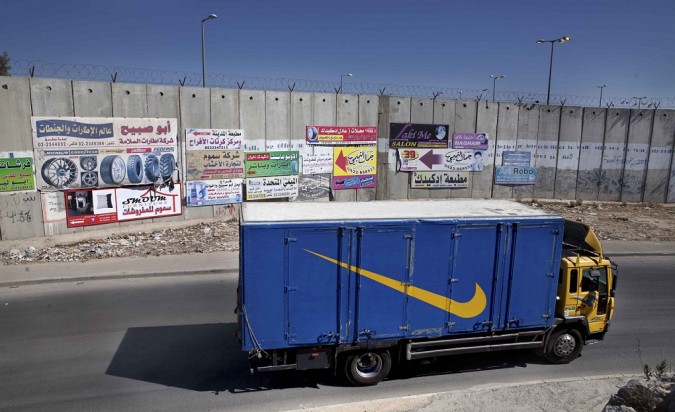Then amid the shrubs, you glimpse something black. You glimpse a rifle barrel. And you get it. You are stuck in the traffic, but the smoke on your right is not undergrowth burning in the fields: it’s tear gas. In the middle, these 13-year-olds with a sling and a keffiyeh. Slim. Fast. It isn’t traffic: they are clashes. But you are the only one who looks. Everybody else, in his car, headphones on, keeps on texting. Step away!, the driver shouts – not to a soldier, yet: to a kid. Palestinians honk, running out of patience. Let’s go, yalla. It’s late.
On the new map of Ramallah, the Wall is listed among the tourist must sees. “Disheartening,” the caption says, “yet fascinating.” Because that’s what Ramallah is. The first photo I took here, my very first day, it was 2007, is a dusty child who drinks rain water from a tank. Now that tank is the swimming pool of the Mövenpick Hotel, 200 dollars per night. Now Ramallah, temporary capital city of Palestine, is café and restaurants everywhere, it’s all shops, lights, flowers, basalt pavings, the music of Justin Bieber pumped up till dawn. Because with Salam Fayyad, appointed prime minister amid the ruins of the Seconda Intifada, in 2007, it’s been resolved that it makes no sense to insist on negotiating, that the only way out is to build this independent state, literally, brick by brick, so as to see it eventually recognized by the UN: and so to get a loan, here, to get a mortgage has become easy. And everybody bought a house, a car. The washing machine. Everybody started a shop. In Ramallah you don’t feel the occupation anymore. We are still 15 miles from Jerusalem, and the trip still takes two, three hours – it depends on the soldiers’ mood: and only if you hold a permit, of course: because in between Ramallah and Jerusalem, there is still the checkpoint of Qalandya. There is still the Wall. Now yet, the Israelis wear this fluorescent bib as if they were highway maintenance workers, one of them picks up kindly off the ground a coin dropped from the bag of an old lady. And number 18 now isn’t anymore a shabby minivan, but a bus with air conditioning, and it doesn’t leave anymore from a rutty area, but a station with lanes and crush barriers and a wi-fi network. The signpost says: Bus Stop Qalandya.
Because that’s how Ramallah is. Normal.
But then you enter any shop, any grocery: and everything is made in Israel. There is nothing Palestinian, here: not a single egg. Then you walk around al-Masyoun, the affluent neighborhood of banks, of glass and stone office buildings, fifteen storeys, the doormen in uniform, and you come across a wall, suddenly: and behind the wall there is the al-Amari refugee camp, 10,000 people and no water, no electricity, a sliver of Africa – these worn out homes, amid the sticky alleys, these barefoot, threadbare children, with no teeth, goats amid the trash rotting under the sun, you stop to take a few notes and flies cover your hand. There are often casualties, here. Israeli bullets. The manhunt for vaguely defined ‘terrorists’ is almost daily. Shops, yet, don’t close anymore due to bereavement. And the portraits of martyrs have been replaced by billboards with blonde kids and American corn flakes.
Because that’s how Palestine is, today. Contradictory. Complex.
And lost.
The occupation, actually, hasn’t changed. It hasn’t softened. Quite the contrary: if power, as Hannah Arendt said, is the opposite of violence, here the Israeli rule is stronger than ever: because it doesn’t need guns anymore. It’s been internalized. In Qalandya there are often brawls: not to tear down gates and gratings, yet: to form an orderly line.
The world’s attention, understandably, is all for Gaza. All for the blood, the rubble, the dead: the despair: Gaza has been under siege since eight years, there is not even water anymore: only sea water, salt water – but Israel’s weapons, actually, are much more advanced than those stockpiled to attack children: because in the end, 43.5 percent of the population of Gaza is under 14: Israel’s weapons are not jets and tanks, but rather laws and procedures. “There are less checkpoints than in the past, it’s true, and now anyway searches and inspections are minimal,” explains Shir Ever, an economist who started studying the West Bank because of its odd prices: roughly 30 percent higher than in Israel, where per capita income, yet, is 20 percent higher than in Palestine. It’s because of transportation costs and administrative burdens. Of longer routes to bypass settlements, of foodstuffs that expire in wait for countless permits: it’s because of invisible barriers. “The real aim is unpredictability. To make movement unpredictable, something you can’t plan, not to prevent it – so that at a glance, everything looks normal. But then you can be stopped, you can be arrested at any time. Under any pretext. And this push Palestinians to stay within their own city. It’s not only Gaza to be separated from the West Bank, but Ramallah to be separated from Nablus, and from Hebron and Jenin. From Jerusalem. Because you never know if you will finally arrive or not, and when: and so, in the end, you give up. You stay at home.” Within your own little world. Because weapons can be new, here, brand new, drones can roam the sky, but the strategy is old: it’s always the same: it’s the divide and conquer.
And this is the fulfilment of the peace process, Shir Ever remarks. Not its failure. The fulfilment of the Oslo Accords. To gradually achieve the self-government of Palestinians, the West Bank was split in areas A, B, and C – furtherly fragmented by settlements in about 120 unconnected islands. Only Area A is under the full control of the Palestinian Authority. 18 percent of the West Bank. 61 percent of the West Bank is Area C, under the full control of Israel: and that’s where the struggle is really taking place. In rural areas. Where the occupation is as always. “Because Israel aims at the land of the West Bank, not the land of Gaza. The opposite, actually. By getting rid of Gaza, it would get rid of 1.8 million Arabs. And it could annex the West Bank, or more exactly, the cities of the West Bank, without jeopardizing its Jewish majority. It could keep Ramallah, Nablus, in the same way it now keeps Haifa. In a few years, we, the Palestinians, will be the settlers of an Israeli West Bank,” says Mustafa Barghouti, one of the top negotiators.
Articolo Precedente
La svolta ecologista del Papa

Articolo Successivo
Gaza – A photo







